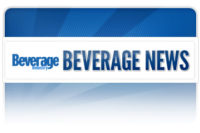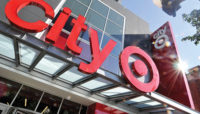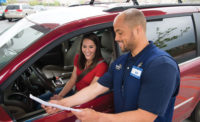Mass merchandisers downsize to meet busy shopper needs
Single-serve beverages appeal to on-the-go shoppers


Vita Coco launched its new Vita Coco Sport drinks exclusively in Target stores as part of the retailer’s “Made to Matter – Handpicked by Target” collection. (Image courtesy of Vita Coco)


In today’s fast-paced world with little down time, consumers are looking for quick, in-and-out shopping trips that fit into their busy lifestyles, says Susan Viamari, editor of thought leadership at Information Resources Inc. (IRI), Chicago. This often results in more frequent store visits with fewer purchases at a time, she says.
Small-format stores are ideal for facilitating this type of behavior, Viamari notes. Therefore, major players in the mass-merchandise and supercenter channels are taking note of this consumer shopping trend and are working to stay competitive by offering small-scale versions of their stores for quicker shopping experiences.
In July, Target Corp. opened a TargetExpress store near the University of Minnesota in Dinkytown, Minn., which also is not far from the company’s hometown market of Minneapolis. The retail giant’s smallest store format boasts 20,000 square feet and is geared toward the needs of urban and college student shoppers in that market, the company wrote in a Jan. 17 post on its blog, A Bullseye View. The TargetExpress store, which is about 15 percent of the size of a typical Target store, draws on the company’s shopper research as well as its experience with its CityTarget store format, which it launched in 2012.
“Target’s research indicates that when consumers head out for quick shopping trips, there are often a number of pain points, including long lines, navigation challenges and uninspiring offerings — all of which Target is hoping to conquer with its latest store format test,” the company wrote in the blog post.
The company responded to these needs with checkout lanes configured for high traffic and smaller basket sizes, as compared with its general merchandise format; smaller hand-held baskets and two-tiered carts to accommodate smaller trips and fewer purchases; and an edited assortment of merchandise, including fresh produce, grab-and-go food and snacks, as well as pharmacy, home, seasonal, electronics and beauty items. If shoppers have trouble finding a selected item in the store, they can access Seamless Service stations throughout the store to search for products in the store or online or text customer service representatives questions for further assistance. For an even faster shopping experience, consumers can shop and pay online and then pick up their products at the service desk in the store.
Less than two months after the opening of its first TargetExpress store, the company announced plans to launch five similar stores in 2015: three in the San Francisco Bay Area, one in San Diego’s South Park area, and one in St. Paul, Minn.’s Highland Park area.
Also looking to bolster its portfolio of small-format stores, Wal-Mart Stores Inc., Bentonville, Ark., announced earlier this year its plans to accelerate its small-store growth by investing in its Neighborhood Market format and opening 270-300 of these stores during its 2015 fiscal year, which ends Jan. 31, 2015. This is double the amount that the company originally planned to open in this time frame, it notes.
For the second quarter of its 2015 fiscal year, which ended July 31, 2014, the company reported that its Neighborhood Market formats continued to perform well, delivering a 5.6 percent increase in comparable store sales for the period. Comparable store traffic in the Neighborhood Market stores grew 4.1 percent in the quarter, compared with a 1.1 percent decrease for all U.S. Walmart stores.
Both of these small-format stores will help these chains appeal to the growing urban population, says David McGoldrick, research analyst at Chicago-based Euromonitor International.
Smaller servings
This trend of mass merchandisers shrinking their store sizes also applies to beverage package sizes in the stores. As these stores become more geared toward quick shopping trips, consumers are opting for beverage packages sized for grab-and-go consumption occasions, points out Matt Hudak, U.S. beverage analyst for Euromonitor. Although bulk beverage sales still make up a large portion of the channel’s total beverage sales, single-serve sizes are showing more growth, he says.
“Consumers might be trying to cut out packaged beverage [purchases], but sometimes the single-serve [package] on the end-cap or by checkout encourages the impulse purchase to drink on the way home,” he explains.
In addition, the small store sizes limit the variety of beverage types and packaging sizes that retailers can carry, IRI’s Viamari notes. “The smaller format, in turn, makes the need to plan assortment carefully even more important,” she explains. “Assortment must reflect the needs of core shoppers, or those core shoppers will begin to shop elsewhere.”
To anticipate shoppers’ beverage needs and plan their stocks accordingly, Euromonitor’s Hudak suggests that retailers look to beverage sales trends to identify growth areas. “It’s about staying ahead of the curve in terms of what are the growth areas,” he says. For example, premium beverages like sparkling bottled water and premium teas and juices are growing in popularity and can help to boost a store’s beverage sales, he says.
Earlier this year, Target worked to capitalize on this trend toward premium, better-for-you food and beverages by partnering with 17 natural, organic and sustainable brands to introduce exclusive baby, beauty and personal care, grocery, health and household products under its “Made to Matter – Handpicked by Target” collection. In the beverage arena, the company partnered with Broomfield, Colo.-based Horizon and New York-based Vita Coco. As part of this partnership, Vita Coco launched its Vita Coco Sport drinks exclusively in Target stores.
Still thinking big
Although small-format stores and smaller beverage sizes might be the latest trends for mass merchandisers, retailers still are supporting their larger-format stores, including supercenters.
Supercenter stores are showing slow growth because of their level of maturity and the competition they are facing from warehouse and club stores, department stores and variety stores, Euromonitor’s McGoldrick says. However, supercenters tend to offer a full grocery department, which helps ensure a consumer base that returns on a regular basis to replenish their grocery stocks, he says.
Shoppers in this segment tend to use these larger stores for stock-up runs for household goods but also are drawn to the stores’ one-stop-shopping offering, allowing them to purchase apparel, home goods and groceries in one stop, McGoldrick says. In addition, players like Walmart offer low price guarantees, which give consumers prices they can feel good about, he notes.
Beverages accounted for 7.9 percent of total sales in the mass merchandiser and supercenter channel, excluding Walmart, in the past year, compared with
7 percent in 2011, IRI’s Viamari says. Thirty-five percent of beverage categories in the channel are growing, with the largest categories — carbonated soft drinks and coffee — growing 4.3 percent and 3.1 percent, respectively, in the past year, she says. Sports drinks also grew 8.5 percent, she adds.
Hot beverages, including different formats of brewed and ready-to-drink coffee and tea; refrigerated juices, including premium brands; and private-label bottled water also are performing well in the channel, Euromonitor’s Hudak says.
Moving forward, food and beverages will continue to be strong drivers of foot traffic in both the large- and small-format stores, IRI’s Viamari says. “Getting assortment right [and] matching it with the unique needs and wants of core shoppers and to the unique needs and mindsets prevalent in key trip missions will remain a significant focus,” she says. “This will impact pack size, pricing strategies, and overall marketing storylines.”
Looking for a reprint of this article?
From high-res PDFs to custom plaques, order your copy today!









